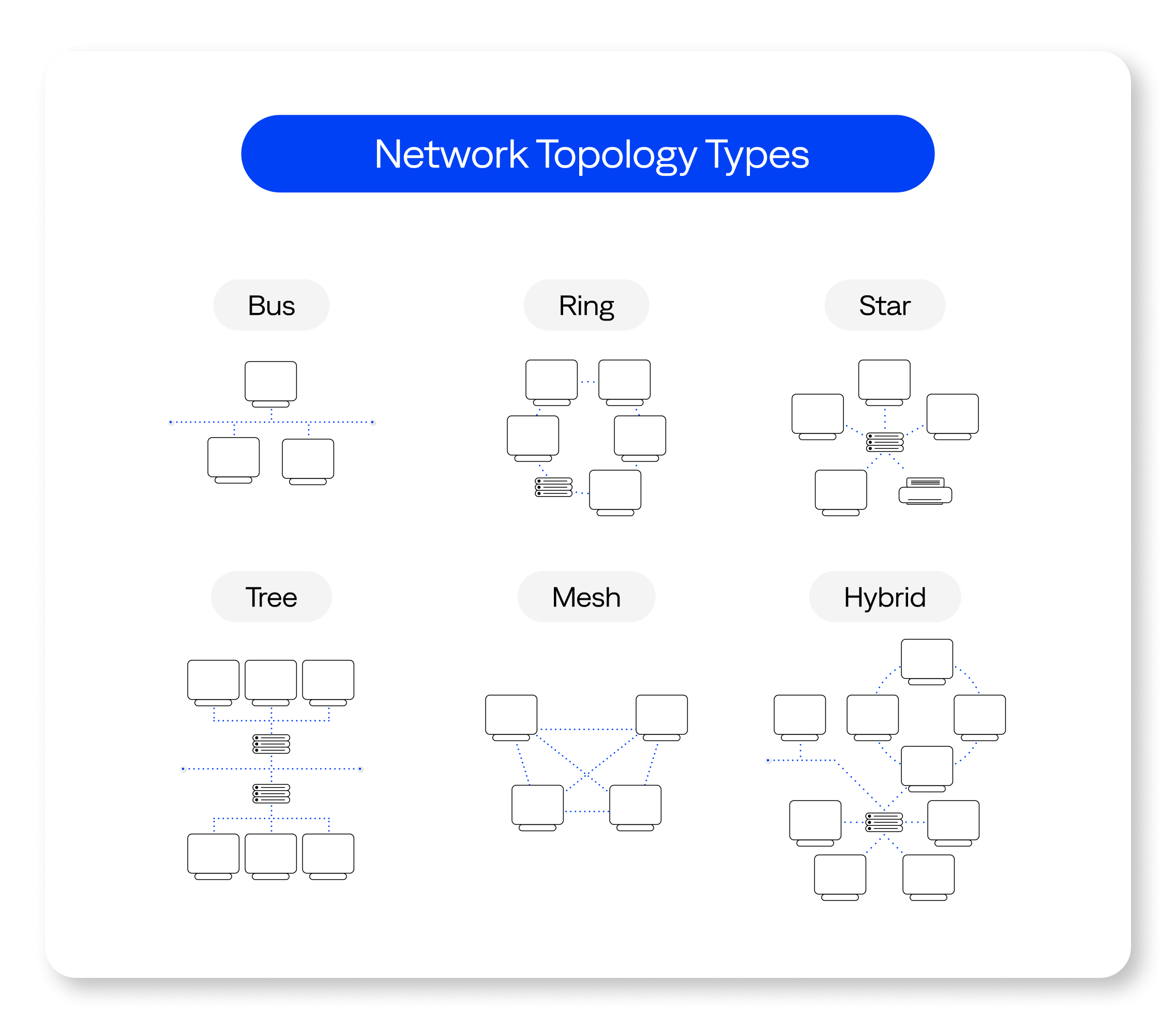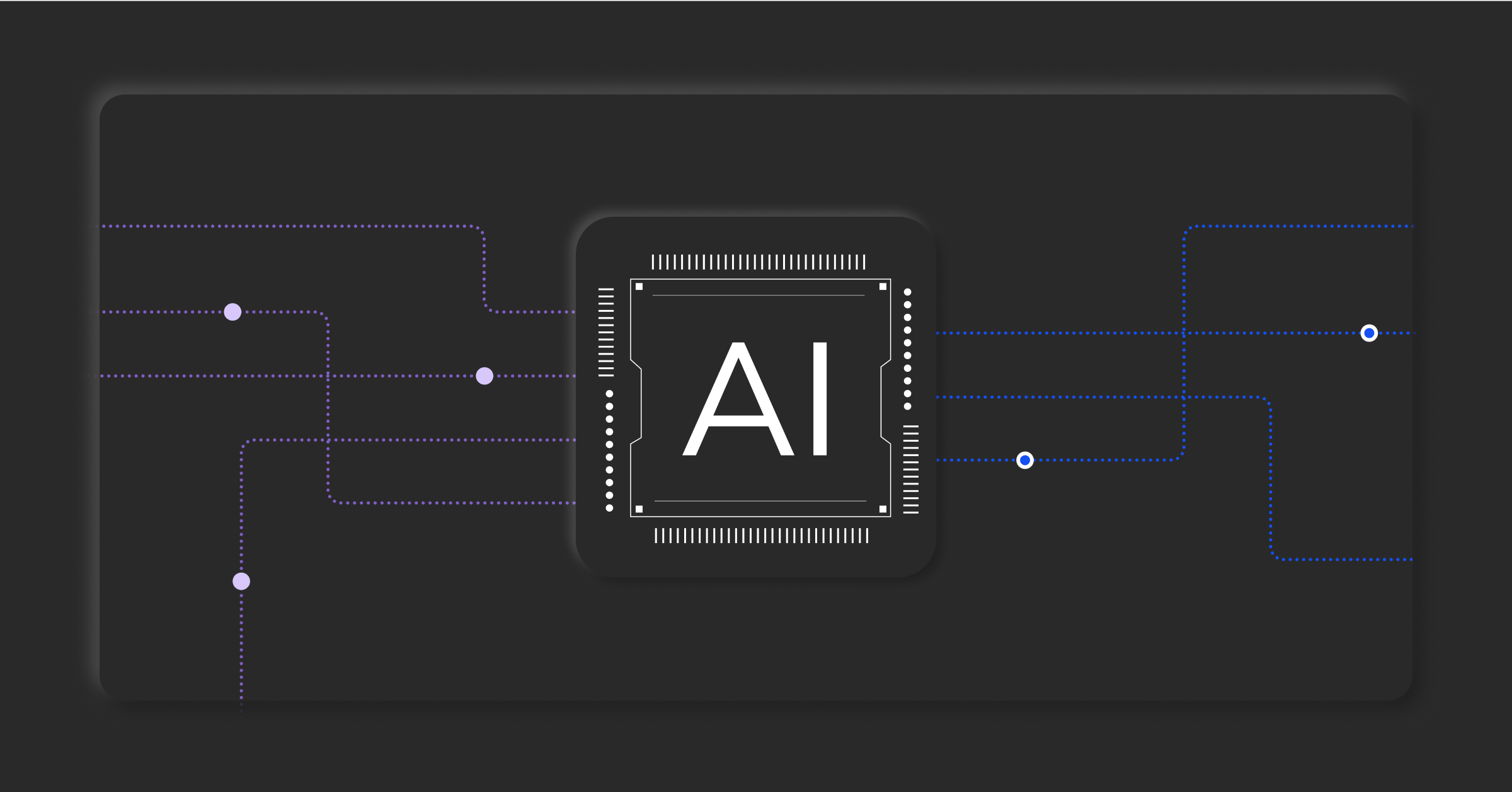1
What is network topology?
Network topology describes how a network‘s nodes, connections, and devices physically arrange and interconnect, as well as how they communicate.
The arrangement or configuration of a network’s components plays a crucial role in ensuring smooth ITOps with minimum downtime. Any issues in the network can disrupt operations, leading to potentially dire consequences. To prevent this, you need to understand your network functionality and structure.
At a high level, there are two primary types of network topology, physical and logical:
- Physical network topology refers to the tangible connections and interconnections — such as cables and wires — between the network and its nodes (switches, routers, repeaters).
- Logical network topology involves the network’s conceptual framework, focusing on the rationale for its arrangement and data flow within it.
2
Six network topology types

The various physical network topologies use different node-and-link configurations and offer unique advantages and disadvantages. For example:
Bus topology
In a bus topology, all network devices connect to a central single cable called the bus or backbone. Data transmission occurs in both directions along the bus; each device can communicate with every other device on the network.
- Bus topology advantages: Simple and cost-effective, a bus topology needs less cable than other options. It’s easy to set up for small networks.
- Bus topology disadvantages: This approach has limited scalability and efficiency. Performance levels degrade due to increased data collisions as you add more devices. If the central cable fails, the entire network goes down.
Ring topology
A ring topology forms a circular data path, with each device connecting to two other devices. Data travels in one direction around the ring network until it reaches its destination.
- Ring topology advantages: The primary benefit of a ring topology is the ability to handle high-volume traffic due to the predictable data transmission path. It’s also relatively easy to install and troubleshoot.
- Ring topology disadvantages: It’s crucial to implement a dual-ring topology for redundancy; the failure of one device or connection can disrupt the entire network. Adding or removing devices can cause temporary network disruption.
Star topology
In a star topology, a central hub or switch connects all devices. Each device has a dedicated connection to the hub, enabling direct communication through the central point. A typical example is a traditional local area network (LAN) in which all devices connect to a central hub.
- Star topology advantages: Star networks are easy to manage and troubleshoot. If one device or its connection fails, it doesn’t affect the rest of the network. They allow high scalability, enabling your network to accommodate additional devices without disruptions.
- Star topology disadvantages: The central hub represents a single point of failure: If it goes down, the entire network becomes inoperative. Star topologies may require additional cabling and hardware, which can inflate costs.
Tree topology
A tree topology integrates multiple star topologies using a bus structure, visually resembling a hierarchical layout similar to a tree with branches. Groups of star-configured devices connect to a linear bus backbone, utilizing features from both bus and star topologies.
- Tree topology advantages: The hierarchical structure is the tree topology’s most significant benefit. This approach simplifies network management and expansion. You can segment network resources to enhance overall efficiency and performance.
- Tree topology disadvantages: This network design can be complex to configure and is dependent on the central bus. A backbone failure can isolate and potentially disable parts of the network.
Mesh topology
A mesh topology features a network structure in which each device connects to every other device, creating a web. You can implement this approach in two ways. In a full mesh topology, every device directly connects to all others. In a partial mesh topology, only some devices have multiple connections.
- Mesh topology advantages: The benefits include high reliability and redundancy. In a connection failure, the network can redirect data through an alternate path, ensuring continuity. Mesh topologies support high data traffic, making them ideal for environments requiring robust data transmission.
- Mesh topology disadvantages: Installing and managing a mesh network is expensive and complex because it requires extensive cabling and configuration.
Hybrid topology
Not surprisingly, a hybrid topology combines elements of two or more topologies, integrating their strengths and mitigating weaknesses. For example, a hybrid topology might combine star, ring, and bus configurations.
- Hybrid topology advantages: You can tailor a hybrid topology to address diverse needs. Resilience to single points of failure makes it ideal for large, complex networks with varying performance and reliability demands.
- Hybrid topology disadvantages: A hybrid approach can be complex and expensive to design, implement, and maintain, especially for large networks.
3
What is the role of network topology in observability?
Network topology is integral to observability, the ability to monitor and manage a network’s health, performance, and behavior.
Network topology provides a clear roadmap for the arrangement and interaction of components, giving IT teams a better view of system behavior, performance, and potential network issues. This perspective helps them monitor and optimize network performance more effectively.
Here are three ways network topology contributes to observability:
Mapping system components and their relationships: A detailed network topology visually represents system components and interconnections, helping administrators pinpoint each device’s location and understand the interactions. This clarity is crucial for proactive IT infrastructure monitoring, network health, and performance management.
Tracing data flows and predicting bottlenecks: Network topology allows you to trace data flows across the network. By understanding data movement from node to node, administrators can detect potential bottlenecks or congestion points. This insight helps diagnose performance issues and optimize data paths, reducing latency and enhancing overall network performance.
Understanding system interconnections and dependencies: Network topology clarifies a system’s dependencies and interconnections, showing how components rely on each other. Administrators can better manage changes, troubleshoot issues, and plan upgrades or expansions. They can also predict the impact of changes and ensure effective dependency management. This holistic view supports proactive management, allowing IT teams to build substantial network maintenance, disaster recovery, and capacity planning strategies.
4
Seven benefits of topology-driven observability
Your organization can benefit from topology-driven observability in the following ways:
Comprehensive visibility of the IT environment: With topology-driven observability, ITOps have a complete picture of the network’s structure and components. Visibility enhances the understanding of how unique elements interact, preventing any overlooked areas. At the same time, it facilitates effective IT infrastructure monitoring and management of the entire IT setup.
Faster incident detection and triage: By understanding expected data flows and configurations, teams can more quickly detect anomalies and deviations, leading to faster incident detection. Speed is crucial for incident triage, allowing you to prioritize and address issues before they escalate.
Better impact analysis and prioritization: When an issue arises, topology-driven observability helps determine its impact on the overall network. By understanding component interdependencies and relationships, you can assess incident severity more accurately. This way, you can promptly prioritize and resolve critical issues that affect vital services.
Streamlined root-cause analysis and troubleshooting: Network topology-driven observability simplifies root-cause analysis. By pinpointing the exact location and source of problems, you can reduce the time and effort required to troubleshoot, which enhances the resolution efficiency and minimizes downtime.
Proactive identification of potential issues and bottlenecks: Continuous topology monitoring lets you identify possible problems and bottlenecks before they impact performance. With early detection, you can take preventive actions like rerouting network traffic or upgrading infrastructure to prevent disruptions and maintain optimal operation.
Improved collaboration: A well-documented network topology fosters knowledge sharing among ITOps teams. A common reference point helps teams better understand the network structure to discuss issues or changes. A shared understanding enhances teamwork and accelerates problem-solving.
Support for resource optimization and capacity planning: Knowing where you’re currently using resources and where demands are likely to grow, you can make more informed decisions about scaling and distribution. Ultimately, this helps keep the network running smoothly and prevent wasteful use or resource shortages.
5
Gain full-stack visibility with topology mesh
BigPanda Real-time Topology Mesh provides your ITOps teams with a detailed, always up-to-date view of your entire IT stack. BigPanda creates a unified real-time topology model by integrating configuration, cloud, and virtualization management data, along with service discovery, APM, and CMDB tools. It also uses built-in integrations and a robust topology REST API to ensure comprehensive full-stack visibility in a single view.
The real-time model helps you quickly understand topological connections and patterns, even in complex environments, to simplify the assessment of incident impact and response prioritization. Moreover, the topology-driven correlation accurately links alerts to the mesh, identifying missing issues. It speeds up and refines root-cause analysis using contextual and change data across the topology.



